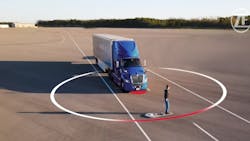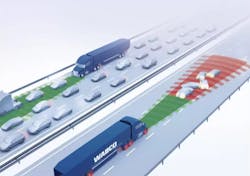The use of automatic emergency braking systems (AEBs) has grown over the past few years as fleets look for one last safeguard to prevent collisions. And that's what the advanced driver assistance system (ADAS) seems to do.
Federal Motor Carrier Safety Administration (FMCSA) findings suggest that the AEB technology can prevent around one-third of heavy-vehicle front-to-rear crashes. With government agencies aiming for "zero deaths" on the road, the mandatory use of AEBs could be coming.
In June, FMCSA and the National Highway Traffic Safety Administration (NHTSA) recently proposed the creation of a new Federal Motor Vehicle Safety Standard (FMVSS) that would require any vehicle with over a 10,000-lb. gross vehicle weight rating (GVWR) to have automatic braking. FMVSS No. 136, which deals with electronic stability control systems, would also be amended. The requirement would go into effect as soon as three years from when the final rule is published.
The Notice of Proposed Rulemaking (NPRM) is currently in the comment stage, and some feedback indicates that the industry does not fully support mandatory AEB adoption at this time due to questions about the technology's reliability. Reports of "phantom braking," a dangerous phenomenon where the AEB initiates for no discernible reason, are under investigation by NHTSA. This has some in the industry wondering if the agencies should pump the brakes on AEB mandates and work out any potential bugs that could themselves potentially cause an accident.
He continued:
"While there are many operational concerns about using an AEB system, truckers are especially worried about the potential for false activations. As you can imagine, drivers are concerned the 80,000-pound truck they are driving could unexpectedly brake to a complete stop for no reason. In the face of this threat, the best the Agencies offer in their NPRM is, 'some assurance that an AEB system is capable of differentiating between an actual imminent collision and a non-threat.' For drivers who have years of experience and millions of accident-free driving, it is inconceivable that the government would require them to hand over control of their vehicle to a technology that may or may not be able to accurately detect a threat."
Spencer's concerns were echoed at Shell Rotella's SuperRigs 2023 truck show in Gillette, Wyoming, in June.
"I'm not a fan of [AEBs]," said Nichole Cheek, a driver for North Country Logistics. "For one, I think it's dangerous. If an emergency or something like that happens and you can't get the truck off the road, then what? You're impeding traffic, you can cause a wreck, or somebody can get injured."
Barry Kasdorf of Jade Transportation worried that sensors trumping a driver's skills could also lead to disaster.
"If you went into a corner, [and the system] thought you're going too fast, it would throw the brakes on," Kasdorf explained. "I've never had it happen in adverse weather with snow and ice, but I don't think you'd want that. It would throw you into a skid."
Limitations and concerns
While AEBs have come a long way, and the industry generally agrees that they work well, problems have arisen. In one recent example, 18 Freightliner Cascadia (MY 2017-2022) trucks equipped with Detroit Assurance AEB, a Daimler product, experienced sudden, unexpected stops. This led to a NHTSA investigation into these "false positive events." During the Office of Defects Investigation, NHTSA duplicated the unintended braking event during a "steel trench plate" scenario.
When asked for comment, a spokesperson from Daimler stated that the company is committed to the safety potential of AEBs and shares the same mission as NHTSA. The spokesperson also stated that Daimler will continue to work with the federal agency to review AEB technology and upcoming regulations and tests. The probe could involve up to 250,000 AEB-equipped Freightliner Cascadias (a Daimler nameplate), model year 2017 through 2022.
If this were the only case of driver difficulties with AEBs, 18 Freightliners might not make for much news. But Mesilla Valley Transportation Solutions has experienced similar situations while testing vehicles with AEBs, but the make and model of the vehicles and the AEBs were not disclosed for legal reasons.
"We've had situations where the system would malfunction randomly and lock the brakes so bad that it actually flat-spotted the steer tires," said Daryl Bear, COO and lead engineer at Mesilla Valley. "When we first got this vehicle, it shook a lot. And then, when we switched the tires, it got better. But then this braking issue happened, and it flat-spotted the second set of tires, and we realized what had happened to the first set."
A sign of things to come
With at least three years until AEBs would become mandatory, developers have time to exorcise any phantoms and instill more confidence with the automatic braking systems in drivers. OOIDA also isn't opposed to AEB mandates if operators' concerns have been addressed and more testing shows the issues have been resolved.
"We hope DOT will listen to truckers and take all the time that is necessary to address the potential shortcomings of these systems," Spencer noted. "Truckers are not opposed to a technology that will help improve their safety and the safety of other motorists. But until the agencies can offer assurance this mandate will improve safety for all highway users, it should not move forward."
Manufacturers are working to provide those assurances. Sensors and cameras are expected to become more accurate with coming improvements.
As ZF and other safety-system developers such as Bendix, Volvo Group, and Daimler Truck optimize AEB and other advanced driver assistance systems (ADAS), newcomers to the industry are looking to assist drivers by removing them from the driver's seat. By the end of the decade, it's likely the autonomous vehicle solutions being tested now will find several feasible applications. AEBs are key systems aboard vehicles that operate autonomously.
One logistics company, Loadsmith, is counting on it, having ordered 800 trucks equipped with Kodiak Driver self-driving technology. The company is expected to start receiving the AVs in 2025.
Brett Suma, CEO and founder of Loadsmith, is confident the current AEB technology, which also serves as a fail-safe for AVs, will improve.
"For the people that have a hesitancy about it, every day technology gets better, every day sensors get better," he noted.
Someday, though, AVs may evolve to not even need AEBs.
"Eventually, if we can show that [AEB] is not needed and the federal government agrees and grants exemption, we wouldn't need to put them on," Kodiak Robotics Chief Technology Officer Andreas Wendel said. "But at the moment, they do provide a really good baseline."
This means that Kodiak's Kenworth T-680s equipped with Bendix Wingman Fusion and Kodiak Driver work within the same parameters as a human driver. And part of the reason AVs are likely to keep this baseline is that AEB technology has already been thoroughly tested.
"They have also been tested for many miles, and there's good data behind them," Wendel explained. "Safety is our number one priority, so having these systems on at the moment doesn't hurt us. It helps us overall, and that's why we'll have them on for the foreseeable future."
As for AEB systems in general?
"Imagine a situation where a human driver fails to take action, then the automated emergency braking system actually jumps in and corrects for that mistake," Wendel said. "If you look at it from a safety envelope, it is great if, even in 10% of these situations, the AEB system saves the day. That is a net positive."
Every fleet must come to its own conclusions on whether AEBs are suitable for them and their drivers. But it seems likely that the number of AEB systems in the commercial vehicle market will only continue to grow, as the technology's life-saving potential is well worth stumbling over a few speed bumps along the way.
About the Author
Alex Keenan
Alex Keenan has been associate editor for Endeavor's Commercial Vehicle Group, which includes FleetOwner magazine, since 2022. She has written on a variety of topics for the past several years and recently joined the transportation industry, reviewing content covering technician challenges and breaking industry news. She holds a bachelor's degree in English from Colorado State University in Fort Collins, Colorado.

